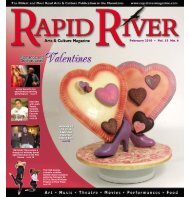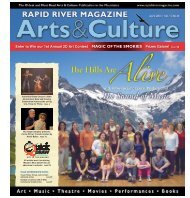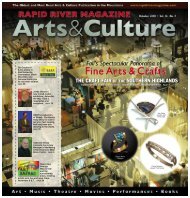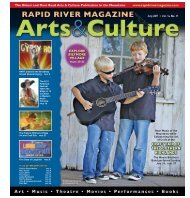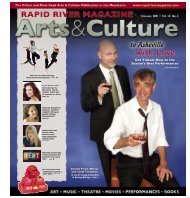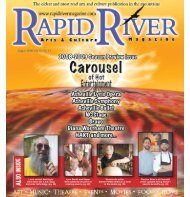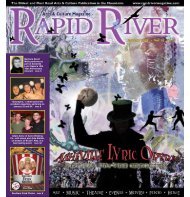JOHN MAC KAH - Rapid River Magazine
JOHN MAC KAH - Rapid River Magazine
JOHN MAC KAH - Rapid River Magazine
Create successful ePaper yourself
Turn your PDF publications into a flip-book with our unique Google optimized e-Paper software.
R A P I D R I V E R A R T S & C U L T U R E<br />
spinning<br />
discs<br />
CD Reviews<br />
by James Cassara<br />
There are a lot of new goodies to cover this month so I’ll try to keep my<br />
comments short and sweet. I hope these reviews inspire you to check out a<br />
disc or two and, as always, I encourage you to buy your music at any of our<br />
excellent independent record stores.<br />
Willie Nelson and Winton Marsalis<br />
featuring Norah Jones<br />
Here We Go<br />
Again<br />
EMI Music<br />
It’s gotten so<br />
the side projects<br />
that Willie Nelson<br />
takes on are often<br />
more interesting<br />
than are his proper albums. While he may<br />
be one of our most esteemed country artists,<br />
his music has long crossed the boundaries<br />
between genres, making these types of couplings<br />
seem more and more logical.<br />
Recorded over two sold-out nights at<br />
the Rose Theatre and at the Lincoln Center,<br />
these performances show both Marsalis and<br />
Nelson at their most relaxed, settling into a<br />
comfortable groove that can only come with<br />
years of experience. Marsalis, who doubled<br />
as arranger for this project, conceived the<br />
music as both a tribute to Ray Charles and<br />
as a loosely connected song sequence exam-<br />
ining the few highs and many lows of love.<br />
Backed by his working quintet of<br />
tenor saxophonist Walter Blanding, pianist<br />
Dan Nimmer, bassist Carlos Henriquez,<br />
and drummer Ali Jackson, and augmented<br />
by Nelson’s long-time harmonica player<br />
Mickey Raphael, the music feels delightfully<br />
appropriate for the subject. Be it “Busted,”<br />
“Hit the Road Jack,” “Makin’ Whoopie,” or<br />
even the iconic “What’d I Say,” everything<br />
here sounds novel and fresh, and while<br />
Charles himself couldn’t be there I’ve no<br />
doubt his spirit was hovering stage left. ****<br />
Robbie<br />
Robertson<br />
How to Become<br />
Clairvoyant<br />
429 Records<br />
Any list of the<br />
100 most iconic<br />
songs in American<br />
music would likely include more than a few<br />
Robbie Robertson songs. It could well be<br />
argued that both “The Weight” and “The<br />
Night They Drove Old Dixie Down” would<br />
make the top 25. It is such lofty heights,<br />
reached before Robertson hit the quarter<br />
century mark, that makes his solo work pale<br />
even more in comparison. With few excep-<br />
tions, his post-Band work has been largely<br />
forgettable, encompassing a handful of<br />
lackluster albums, a few genuinely puzzling<br />
soundtracks, and the odd contribution to<br />
various tribute albums.<br />
For How to Become Clairvoyant, his<br />
first album in more than a decade, Robertson<br />
seeks to reestablish his street creed by<br />
bringing in a list of heavy hitters (Clapton,<br />
Winwood, Trent Reznor) but the results are<br />
no less unimpressive. Despite the occasional<br />
bit of authenticity, the album feels suspiciously<br />
shallow, bereft of any real identity.<br />
There are undoubtedly moments of flourish<br />
– “When the Night Was Young” is certainly<br />
signature Robertson – but for the most part<br />
Robertson again seems content to assume<br />
the role of supporting player on his own<br />
album.<br />
There’s precious little in the way of<br />
guitar fireworks, the arrangements have a<br />
maddeningly synthetic feel, and Robertson’s<br />
voice is at best serviceable. Even worse, his<br />
lyrics – at one time compelling, moving, and<br />
even revelatory – have become increasingly<br />
narcissistic and puffy. It pains me to write<br />
this, as at one time his music moved me<br />
in a fashion few artists could. But in many<br />
ways Clairvoyant<br />
confirms what many of<br />
us suspected: Robertson may have been the<br />
intellectual center of The Band, but Levon,<br />
Richard, Garth, and Rick were its heart and<br />
soul. **<br />
Ray Charles<br />
Live in Concert<br />
Concord<br />
Records<br />
Now this, my<br />
friends, is the real<br />
deal. Brother Ray<br />
was at the top of his game when he stepped<br />
onto the stage at Los Angeles’ Shrine Audi-<br />
torium to kick off what would become one<br />
of his most seminal tours. His voice was in<br />
great shape, rested after a period of relative<br />
calm, and the band’s extensive road experi-<br />
ence allowed them to push the music in new<br />
and exhilarating directions.<br />
Unlike some of the live shows culled<br />
from this period, the sound – courtesy of ace<br />
engineer Wally Heider – is brilliant, rich and<br />
warm, with Charles’ voice out front where<br />
it belongs. There’s a catlike version of “Hal-<br />
lelujah I Love Her So,” replete with nuance<br />
and subtle shifts in tone, while the power<br />
and majesty of “Don’t Set Me Free” offers a<br />
nice change of tempo.<br />
Even the signature “What I Say”<br />
manages to sound fresh and exciting, with<br />
Charles and the band, spearheaded by David<br />
“Fathead” Newman, charging ahead as if<br />
they were playing it for the first time. These<br />
dozen tracks are priceless, a dazzling snap-<br />
shot of an artist moving his music in new<br />
and dynamic directions.<br />
The only downside is in the packaging;<br />
Ray Wards’ liner notes are woefully<br />
incomplete (not even the band credits are<br />
accurate!) which does a disservice to the<br />
music and those making it. On the flipside,<br />
Ray Hearne’s photographs of Charles and<br />
company are marvelous and nearly worth<br />
the price of the disc.<br />
Quibbles aside, this release is a welcome<br />
addition to the already unmatched<br />
catalog of Ray Charles. There’s a reason he<br />
was called The Genius, and while I cannot<br />
imagine anyone needed further evidence<br />
of why he was, Live in Concert<br />
offers up<br />
plenty. ****1/2<br />
Aztec<br />
Camera<br />
Walk Out<br />
To Winter<br />
Music Club<br />
Man oh<br />
man, do I miss<br />
this band! Of<br />
course Aztec Camera were never really a<br />
fully fledged group but rather Roddy Frame<br />
and whoever tagged along. But for a decade<br />
or so, roughly spanning the years 1983 to<br />
1995, few artists produced more perfect pop<br />
records. Be it the early years of folk eclectic<br />
to the later rhythm and blues tinged studio<br />
manifestations, Frame rarely failed to please;<br />
even his misses (and there were plenty) were<br />
fascinating lessons in risk taking.<br />
This two disc collection is wisely se-<br />
quenced thematically rather than in any sort<br />
of chronological order. Thus we have the<br />
R&B bounce of “Deep and Wide and Tall”<br />
followed nicely by the Dylan-inspired “Birth<br />
of the True”. “Good Morning Britain,” a<br />
killer duet with Mick Jones of The Clash,<br />
showcases Frame’s often overlooked guitar<br />
playing and is the closest he ever got to<br />
mainstream radio play.<br />
Equally dazzling is “The Crying Scene,”<br />
a fiery rocker that by all rights should have<br />
been the band’s biggest hit. And did anyone<br />
write lyrics as delightfully obtuse as “a vision<br />
of love wearing boxing gloves and bringing<br />
hearts and flowers”? Frame could do it all,<br />
from touching ballads designed to melt your<br />
heart to shout out rockers able to burst your<br />
eardrums, and this collection does a heck of<br />
a job of summing up his oeuvre.<br />
Frame’s skill at melding disparate<br />
melodic styles was unparallelled, making his<br />
absence from the music scene even more<br />
bewildering and frustrating. It’s been nearly<br />
fifteen years since he’s released new music,<br />
and while Walk out to Winter<br />
is a wonderful<br />
‘CD’s’ continued on next page<br />
10 May 2011 — RAPID RIVER ARTS & CULTURE MAGAZINE — Vol. 14, No. 9




